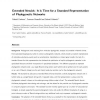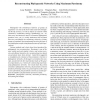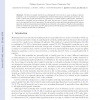90
Voted
TCBB
2010
14 years 11 months ago
2010
—Phylogenetic networks are leaf-labeled, rooted, acyclic, directed graphs, that are used to model reticulate evolutionary histories. Several measures for quantifying the topologi...
104
click to vote
CORR
2007
Springer
15 years 16 days ago
2007
Springer
Abstract—Phylogenetic networks are a generalization of phylogenetic trees that allow for the representation of non-treelike evolutionary events, like recombination, hybridization...
89
Voted
CORR
2007
Springer
15 years 16 days ago
2007
Springer
Phylogenetic networks are a generalization of phylogenetic trees that allow for the representation of non-treelike evolutionary events, like recombination, hybridization, or later...
121
Voted
BMCBI
2008
15 years 20 days ago
2008
Background: Phylogenetic networks are a generalization of phylogenetic trees that allow for the representation of evolutionary events acting at the population level, like recombin...
112
Voted
BMCBI
2008
15 years 20 days ago
2008
Background: Phylogenetic trees resulting from molecular phylogenetic analysis are available in Newick format from specialized databases but when it comes to phylogenetic networks,...
100
click to vote
ALMOB
2007
15 years 21 days ago
2007
Background: Neighbor-Net is a novel method for phylogenetic analysis that is currently being widely used in areas such as virology, bacteriology, and plant evolution. Given an inp...
118
Voted
LPNMR
2009
Springer
15 years 5 months ago
2009
Springer
This note summarizes the use of Answer Set Programming to solve various computational problems to infer phylogenetic trees and phylogenetic networks, and discusses its applicabilit...
117
click to vote
ICCS
2005
Springer
15 years 6 months ago
2005
Springer
Phylogenetic networks model evolutionary histories in the presence of non-treelike events such as hybrid speciation and horizontal gene transfer. In spite of their widely acknowled...
99
Voted
CSB
2005
IEEE
15 years 6 months ago
2005
IEEE
Phylogenies—the evolutionary histories of groups of organisms—are one of the most widely used tools throughout the life sciences, as well as objects of research within systema...
CPM
2009
Springer
15 years 7 months ago
2009
Springer
Evolution is usually described as a phylogenetic tree, but due to some exchange of genetic material, it can be represented as a phylogenetic network which has an underlying tree st...




